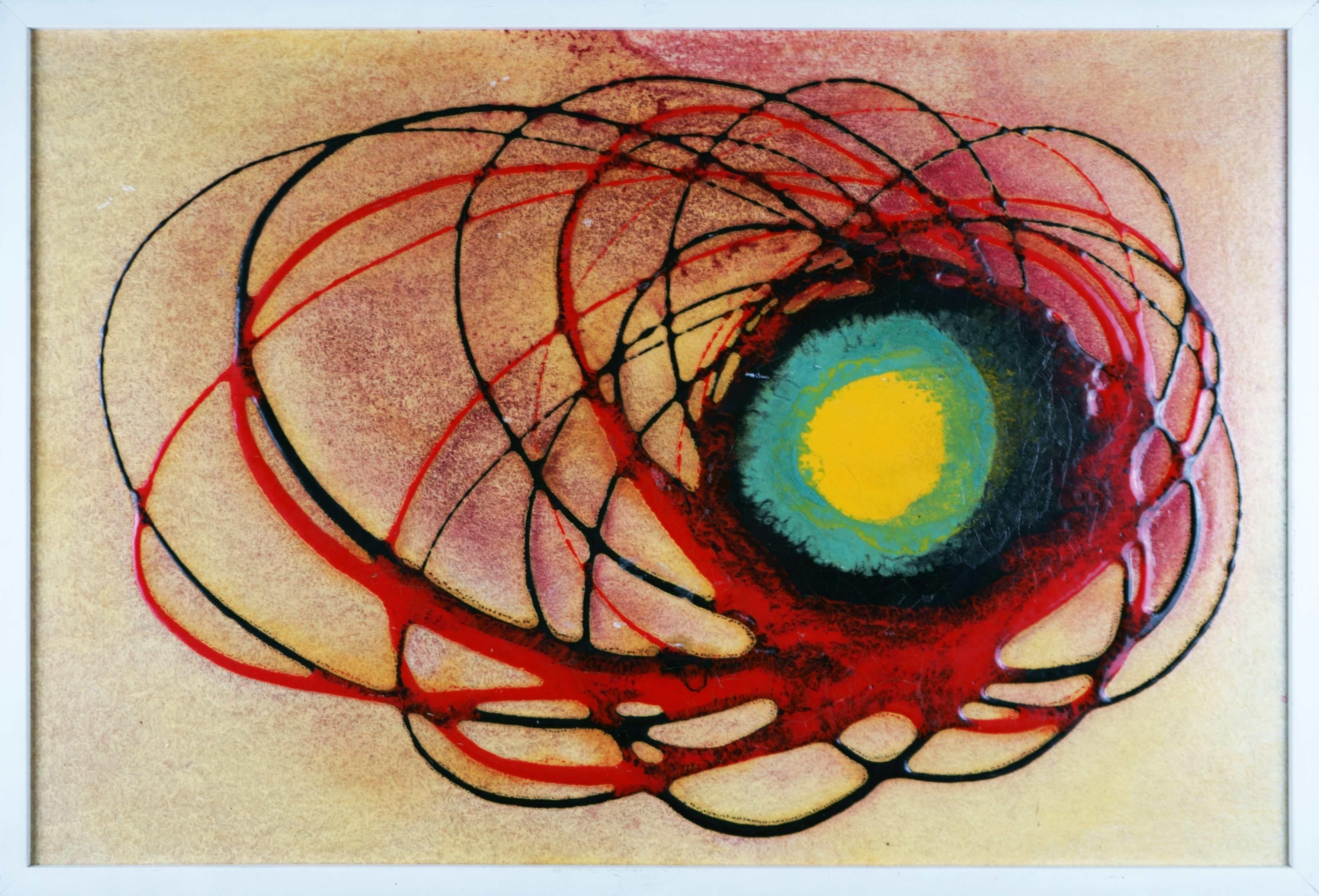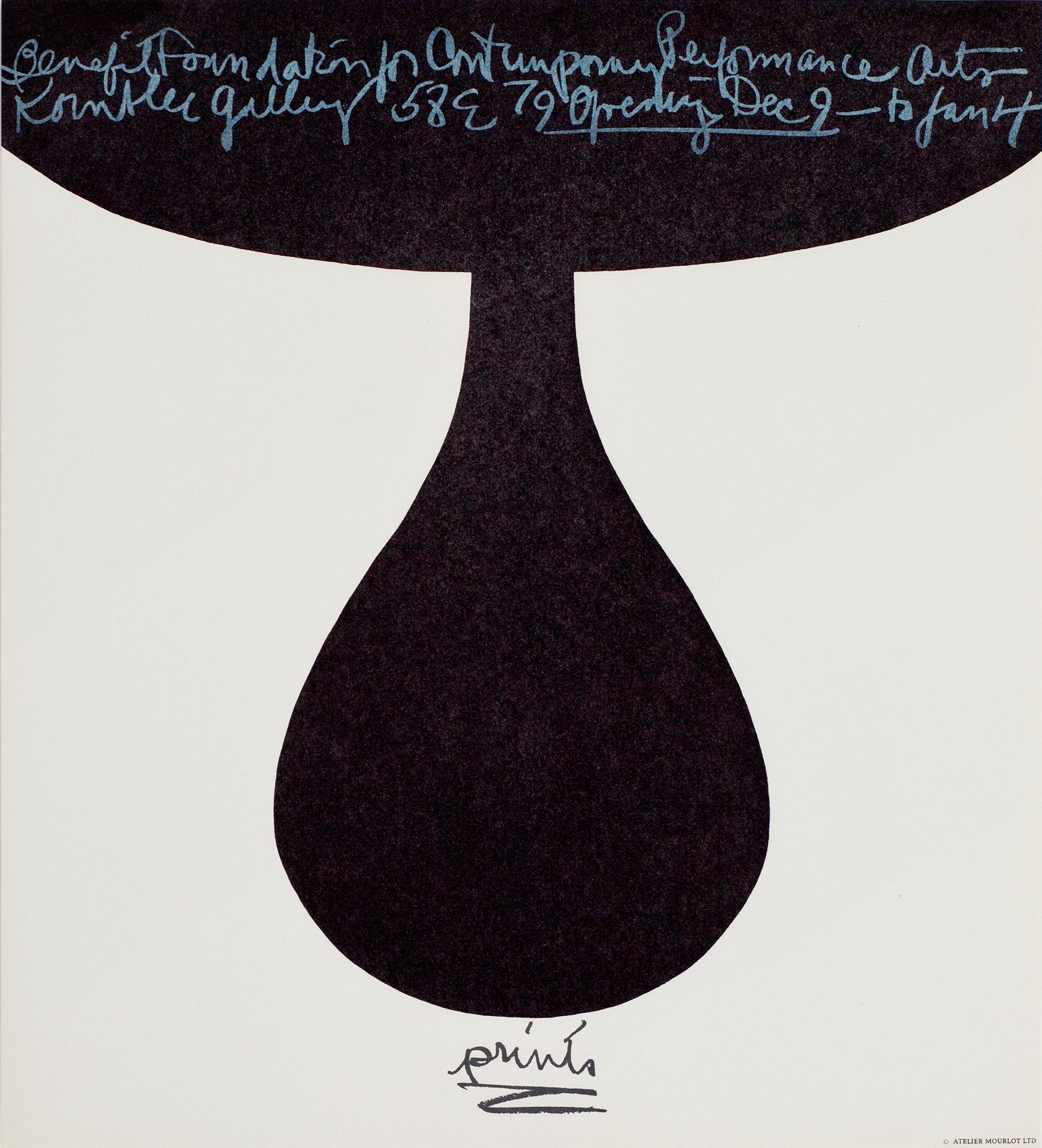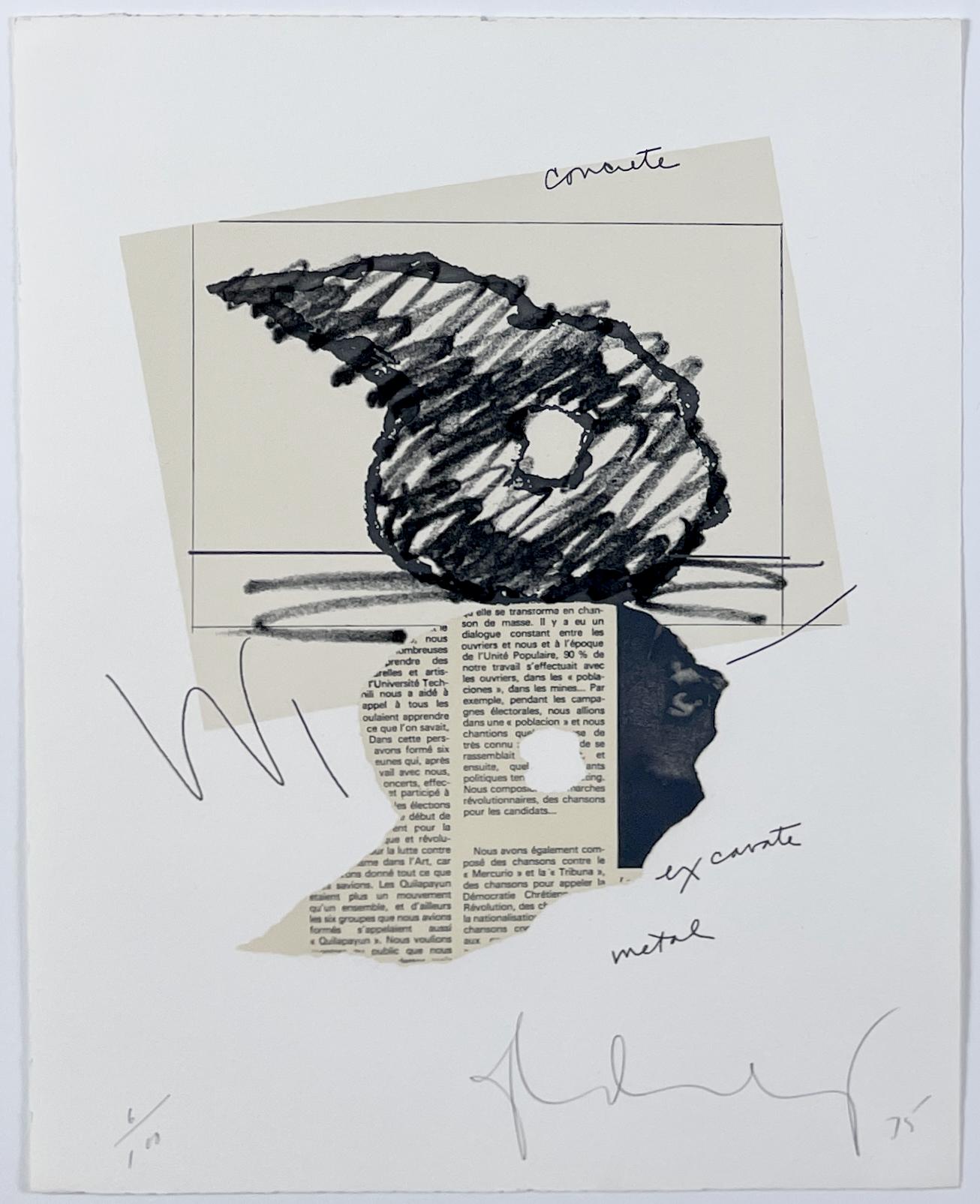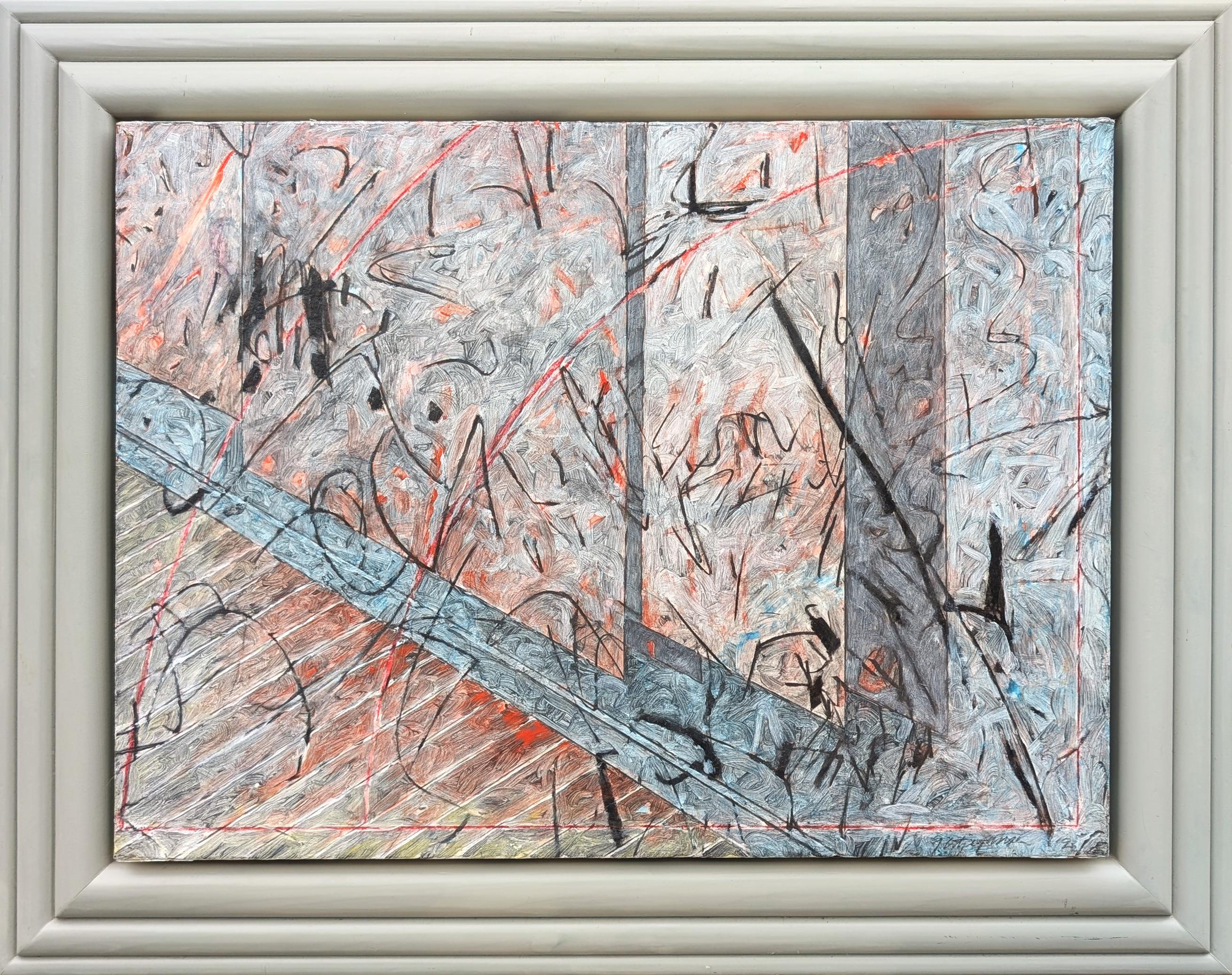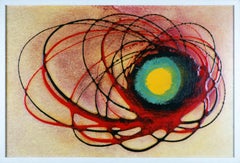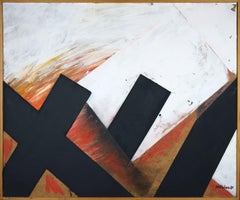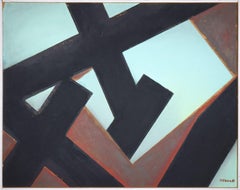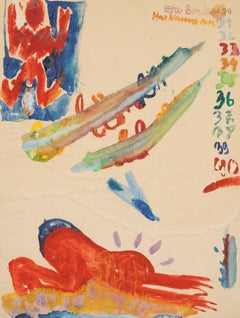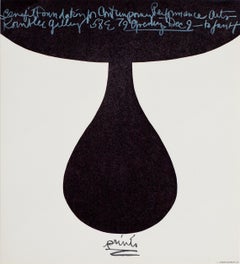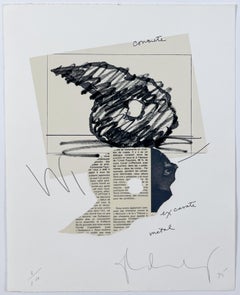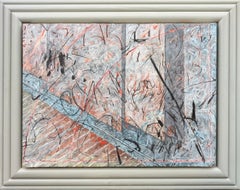Items Similar to Eccentric discharges of a blue-red core / - Energetic traces -
Want more images or videos?
Request additional images or videos from the seller
1 of 9
Klaus OldenburgEccentric discharges of a blue-red core / - Energetic traces -c. 1975
c. 1975
$611.08
$763.8520% Off
£466.42
£583.0320% Off
€520
€65020% Off
CA$861.33
CA$1,076.6620% Off
A$945.91
A$1,182.3820% Off
CHF 493.97
CHF 617.4620% Off
MX$11,289.77
MX$14,112.2220% Off
NOK 6,258.12
NOK 7,822.6520% Off
SEK 5,832.81
SEK 7,291.0220% Off
DKK 3,961.40
DKK 4,951.7520% Off
About the Item
Klaus Oldenburg (*1942 Berlin), Eccentric discharges of a blue-red core, around 1975. paint and cast resin on chipboard, 39 x 59 cm (inside dimension), 42 x 62 (frame), signed on the reverse "Kl. Oldenburg".
- with isolated rubbed spots, otherwise in good condition
- Energetic traces -
About the artwork
Discharges emerge from a blue energy core with a red corona, reflected in black traces of color. A snapshot that freezes the moment and at the same time is an ongoing processual movement. In this way, time itself is represented as a perpetual moment, which further increases the dynamics of the image.
The synthetic resin used creates a glossy surface that literally seals the motif within itself. As a result, it does not appear to have been made by an artist's hand, but as something autonomous that has been fixed by a quasi-scientific process. The flow of the synthetic resin reflected in the motif also contributes to the effect of independence: The energetic discharges have found their adequate visible form in the flowing movements of the material. We seem to be witnessing an event in the atomic or subatomic world that becomes present in the event of form and color. Thus, the abstract art before our eyes is by no means purely abstract, but has a representational connotation and is a rare painterly example of the epoch of the Space Age.
About the artist
Born in Berlin, Klaus Oldenburg studied at the State School of Civil Engineering in Berlin from 1961 to 1964 and then worked as a civil engineer and architect until 1967. From 1967 to 1968 he ran the jazz club and artists' meeting place "Kilroy" in Berlin-Wilmersdorf, and then devoted himself entirely to art as a freelance painter. From 1968 to 1972 he had a studio in Berlin-Kreuzberg and from 1972 in Berlin-Friedenau. Since 1972, Oldenburg, who belonged to the Kreuzberg Bohemians, has shown his work at the Free Berlin Art Exhibition.
GERMAN VERSION
Klaus Oldenburg (*1942 Berlin), Exzentrische Entladungen eines blau-roten Kerns, um 1975. Farbe und Gießharz auf Spanplatte, 39 x 59 cm (Innenmaß), 42 x 62 (Rahmen), rückseitig mit „Kl. Oldenburg“ signiert.
- mit vereinzelten beriebenen Stellen, sonst in gutem Zustand
- energetische Spuren -
zum Kunstwerk
Aus einem blauen Energiekern mit roter Corona emergieren Entladungen, die sich in schwarzen Farbspuren niederschlagen. Eine Momentaufnahme, die den Augenblick fixiert und zugleich ein fortwährender prozessualer Bewegungsablauf ist. Auf diese Weise wird die Zeit selbst als ein sich perpetuierender Augenblick zur Darstellung gebracht, was die Dynamik des Bildes zusätzlich steigert.
Das verwendete Kunstharz erzeugt eine glänzende Oberfläche, die das Motiv förmlich in sich selbst versiegelt. Dadurch wirkt es nicht wie von Künstlerhand verfertigt, sondern als etwas Autonomes, das durch ein gleichsam wissenschaftliches Verfahren fixiert worden wäre. Zur Eigenständigkeitswirkung trägt auch der sich in der Motivik niederschlagende Fluss des Kunstharzes bei: Die energetischen Entladungen haben in den Fließbewegungen des Materials ihre adäquate sichtbare Form gefunden. Wir scheinen einem Geschehen der atomaren oder subatomaren Welt beizuwohnen, das in dem Form- und Farbereignis präsent wird. Damit ist die vor Augen stehende abstrakte Kunst keineswegs rein abstrakt, sondern gegenständlich konnotiert und ein rares malerisches Beispiel für die Epoche des Space Age.
zum Künstler
In Berlin geboren, studierte Klaus Oldenburg von 1961-1964 an der Staatlichen Ingenieurschule für Bauwesen Berlin und war im Anschluss bis 1967 als Bauingenieur und Architekt tätig. Von 1967-1968 führte er den Jazzclub und Künstlertreff "Kilroy" in Berlin-Wilmersdorf, um sich dann als freischaffender als Maler ganz der Kunst zu widmen. Von 1968 bis 1972 hatte er ein Atelier in Berlin-Kreuzberg und ab 1972 in Berlin-Friedenau. Von 1972 an beschickte der zum Künstlerkreis der "Kreuzberger Boheme" zählende Oldenburg die Freie Berliner Kunstausstellung.

About the Seller
5.0
Vetted Professional Seller
Every seller passes strict standards for authenticity and reliability
Established in 2014
1stDibs seller since 2023
22 sales on 1stDibs
- ShippingRetrieving quote...Shipping from: Berlin, Germany
- Return Policy
More From This Seller
View AllEccentric discharges of a turquoise-yellow core / - Energetic traces -
Located in Berlin, DE
Klaus Oldenburg (*1942 Berlin), Eccentric discharges of a turquoise-yellow core, around 1975. paint and cast resin on chipboard, 39 x 59 cm (inside dim...
Category
1970s Abstract Paintings
Materials
Resin
$611 Sale Price
20% Off
Black form surfaces on red painterly ground / - The Double Origin of Painting -
Located in Berlin, DE
Jürgen Möbius (*1939 Großenhain), Black form surfaces on red painterly ground. Oil on hardboard, 50 x 60 cm, 51 x 61 cm (frame), signed "Möbius" and dated "[19]81".
- Small paint chip in upper right corner, otherwise good condition. Gallery frame with slight signs of wear.
- The Double Origin of Painting -
About the artwork
In the painting black, optically dominant forms can be seen, which in their arrangement at right angles to each other have a proto-architectural character. They are, so to speak, always already given original forms. At the same time, however, the forms are surfaces of color, and thus genuine painting. In order to make the painterly character of the painting clearly visible, Jürgen Möbius has applied red-toned strokes that have preserved the brushstroke. These are traces of an act of painting.
The diagonal layers of red strokes merge into the upper white area, which oscillates between brushwork and homogeneous flatness, while the central white field, into which a black bar protrudes, has a decidedly planar character.
The sharp contrast between the autonomous black surface forms, reminiscent of Kasimir Malevich, and the free brushstroke, which is not bound to any motif, creates an enormous pictorial tension, which is conveyed by the white, but at the same time is intensified by the virulent black-and-white contrast.
In addition to the tense contrast of form and color, there is also a contrast between the dynamic of the brushstroke and the static of the black surface forms, whereby the diagonal alignment of these forms also gives the static a dynamic, while at the same time the layered brushstrokes have something static about them.
Added to this structure of tension is the fact that the painting ground, the unprepared hardboard, is clearly present as such in the picture. In this way, it becomes clear once again that we are not dealing with an autonomous cosmos of form and color, as in Suprematism, but with a painting created by the artist's hand.
With this work, Jürgen Möbius explores the possibilities of painting and thematizes painting in terms of its twofold origin, the trace of the guided brush and the painterly form, which gains its independence precisely by absorbing the brushstroke into itself.
About the artist
From 1959 to 1965 Jürgen Möbius studied painting at the University Institute for Art and Work Education in Mainz. He also studied philosophy and art history at the University of Mainz. Afterwards he worked as a freelance artist in Mainz.
At first, Möbius created material reliefs and installations, then, around 1974, he turned increasingly to conceptual art and added cinematic means. During this phase he wrote the manifesto-like essay "Principles of Supranatural Landscape" (1979).
From 1981 on, Möbius concentrated on painting and searched for artistic ways to "treat intellectual and sensual perception equally in the fusion of representational and abstract pictorial elements" (Wolfgang Zemter). He found inspiration on his study trips to Thailand and Sri Lanka.
"The pure painting of Jürgen Möbius flows through us as a timeless expression of memory and energy, ploughing our perception and bringing us the happiness of seeing authentic, immovable form.
- Philippe Büttner
Selection of solo exhibitions
1969 Galerie Würzner, Düsseldorf / Galerie Gurlitt, Mainz
1972 Städtische Galerie, Mainz
1973 Galerie Schloss Ringenberg Rathaus, Kleve
1974 Röderhausmuseum, Wuppertal
1976 Galerie Glasing, Osnabrück / Städtische Galerie, Herne
1977, 1997, 2004 Märkisches Museum, Witten
1979 Studio M, Bamberg / Staatstheater, Darmstadt
1980 Galerie Stolànovà, Wiesbaden / Mittelrheinmuseum, Koblenz
1982 Galerie Dornhöfer, Mainz
1984 Galerie Neumühle, Schlangenbad
1985 Landesmuseum, Mainz / Kunstverein, Ludwigshafen / Nassauischer Kunstverein, Wiesbaden
1986 Museum, Bochum / Galerie der Stadt Iserlohn
1987, 1990 Galerie Klaus Kiefer, Essen
1987, 2000 Galerie Ulrike Buschlinger, Wiesbaden
1988 Kunsthalle Darmstadt
1988, 1992, 1996, 1999 Galerie Leonhard, Basel
1992, 2002 Galerie Zulauf, Freisheim
1994 Galerie Remy, Vallendar
1995 Sendezentrum des Zweiten Deutschen Fernsehens, Mainz
2001 Collegium oecumenicum, Bamberg / MVB Forum für Kultur und Wirtschaft, Mainz
2006 Adam Gallery, London
Selection of group exhibitions
1969 ‘International Graphic Arts’, Galerie Dalléas Bordeaux, Paris
1975 ‘Deutscher Künstler-Bund’, Dortmund
1979 ‘Man and man’s Images’, Märkisches Museum Witten
1980 ‘Love-Dokuments of our Time’, Art Hall Darmstadt and Art Association Hannover
1982 ‘Work - Progress – Position’, Nassau Art Association Wiesbaden
1983 ‘Principle Hope – Utopic Aspects in Art and Culture of the 20th Century’, Museum Bochum
1986 ‘Selfportraits’, Gallery Klaus Kiefer Essen
1987 ‘The Dying and Death’, Gallery Klaus Kiefer Essen
1989 ‘Where are You, Revolution – Freedom, Liberty, Egality, Fraternity to-day’, Museum Bochum 1990 ‘Flight – a Problem within the Memory of Man’, Kunsthalle Darmstadt ‘Art and War 1939 – 89’, House of Cultures Berlin
1991 ‘Material and Form’, Pillnitz Castle Dresden and Pfalz Gallery Kaiserslautern
1995 20 Years Exhibitions, Chrämerhuus Langenthal, Schweiz
1998 ‘Works on Paper’, Klaus Kiefer Gallery Essen
2000 ‘Acquisitions 1900 – 2000’, Mittelrhein-Museum Koblenz
2001 ‘Strange Pictures’, Klaus Kiefer Gallery Essen
2002 ‘10 Years Buschlinger Gallery’, Buschlinger Gallery Wiesbaden
2004 ‘Eternal Space – Pictures and Sculptures’, Dome of Bamberg
2005 Art Fair Chicago, Adam Gallery, London
Selected Bibliography
Mittelrheinisches Landesmuseum (Hrsg.): Jürgen Möbius - Neue Bilder, Mainz 1985.
Kunstverein Darmstadt (Hrsg.): Jürgen Möbius. Bilder 1985 - 1988. Kunsthalle Darmstadt, 26. Juni - 14. August 1988. Red. Dorit Marhenke, Lyrik Marcus Schiltenwolf, Düsseldorf 1988.
Gabriele Prusko (Hrsg.): Jürgen Möbius. Mit Texten von Philippe Büttner und Ralph Mieritz, Basel 1992.
Wolfgang Zemter (Hrsg.): Jürgen Möbius - Aktuelle Arbeiten. Märkisches Museum der Stadt Witten, Bönen 1999.
Wolfgang Zemter (Hrsg.): Jürgen Möbius. Flieger in meinem Zimmer und Beruhigte Zone, Bönen 2004.
Dama Gallery...
Category
1980s Abstract Abstract Paintings
Materials
Oil
Tectonic Tension / - Archetypes of Painting -
Located in Berlin, DE
Jürgen Möbius (*1939 Großenhain), Tectonic Tension. Oil on hardboard, 47.5 x 60 cm, 49 x 61.5 cm (frame), signed lower right "Möbius" and dated "[19]81".
- Upper left corner with a small chip, light scratches and a little rubbed in places. Provisional gallery frame with traces of use.
- Archetypes of Painting -
About the artwork
The form structure in front of the eye is overlapped by the frame. Thus, the frame does not open up a space in which something is presented, but rather shows the seemingly arbitrary section of a comprehensive context that cannot be framed as such.
We see forms that stand in a structure of tension with each other, whereby the individual black and brown forms, which continue almost endlessly beyond the frame, already show a tension in themselves, since they are not only forms, but also surfaces - form surfaces, while the light blue surface ground is at the same time forms that appear as surface forms. The formed surfaces and surface forms are nested within each other and form a structure that encompasses all elements.
The angular arrangement of the black and brown shaped surfaces gives the structure a tectonic character. The tension is thus heightened to the point of paradox, since the black shape at the front is overlapped by the brown shape at the bottom in the center of the picture, which would be impossible in real space. It is precisely through this "paradox" that Möbius demonstrates that the paradoxical is reality within painting. It is, so to speak, the most original possibility of painting, which distinguishes it from the other arts. In combination with the tectonic formations, Jürgen Möbius creates an archaic primordial painting, which, however, should not be confused with the autonomous color and form cosmos of Suprematism à la Kasimir Malevich. Instead of homogeneous, perfectly colored forms, here the colors are deliberately applied unevenly, and the light blue is mixed with the brown in a manner determined by the brushstroke. At the edges of the surface forms, the uneven application of paint allows the wood of the unprimed hardboard to show through. In this way, Möbius illustrates that we are dealing with a painting that has been created by an act of painting - an act, however, that takes hold of the original principles of painting and thus realizes painting as such.
About the artist
From 1959 to 1965 Jürgen Möbius studied painting at the University Institute for Art and Work Education in Mainz. He also studied philosophy and art history at the University of Mainz. Afterwards he worked as a freelance artist in Mainz.
At first, Möbius created material reliefs and installations, then, around 1974, he turned increasingly to conceptual art and added cinematic means. During this phase he wrote the manifesto-like essay "Principles of Supranatural Landscape" (1979).
From 1981 on, Möbius concentrated on painting and searched for artistic ways to "treat intellectual and sensual perception equally in the fusion of representational and abstract pictorial elements" (Wolfgang Zemter). He found inspiration on his study trips to Thailand and Sri Lanka.
"The pure painting of Jürgen Möbius flows through us as a timeless expression of memory and energy, ploughing our perception and bringing us the happiness of seeing authentic, immovable form.
- Philippe Büttner
Selection of solo exhibitions
1969 Galerie Würzner, Düsseldorf / Galerie Gurlitt, Mainz
1972 Städtische Galerie, Mainz
1973 Galerie Schloss Ringenberg Rathaus, Kleve
1974 Röderhausmuseum, Wuppertal
1976 Galerie Glasing, Osnabrück / Städtische Galerie, Herne
1977, 1997, 2004 Märkisches Museum, Witten
1979 Studio M, Bamberg / Staatstheater, Darmstadt
1980 Galerie Stolànovà, Wiesbaden / Mittelrheinmuseum, Koblenz
1982 Galerie Dornhöfer, Mainz
1984 Galerie Neumühle, Schlangenbad
1985 Landesmuseum, Mainz / Kunstverein, Ludwigshafen / Nassauischer Kunstverein, Wiesbaden
1986 Museum, Bochum / Galerie der Stadt Iserlohn
1987, 1990 Galerie Klaus Kiefer, Essen
1987, 2000 Galerie Ulrike Buschlinger, Wiesbaden
1988 Kunsthalle Darmstadt
1988, 1992, 1996, 1999 Galerie Leonhard, Basel
1992, 2002 Galerie Zulauf, Freisheim
1994 Galerie Remy, Vallendar
1995 Sendezentrum des Zweiten Deutschen Fernsehens, Mainz
2001 Collegium oecumenicum, Bamberg / MVB Forum für Kultur und Wirtschaft, Mainz
2006 Adam Gallery, London
Selection of group exhibitions
1969 ‘International Graphic Arts’, Galerie Dalléas Bordeaux, Paris
1975 ‘Deutscher Künstler-Bund’, Dortmund
1979 ‘Man and man’s Images’, Märkisches Museum Witten
1980 ‘Love-Dokuments of our Time’, Art Hall Darmstadt and Art Association Hannover
1982 ‘Work - Progress – Position’, Nassau Art Association Wiesbaden
1983 ‘Principle Hope – Utopic Aspects in Art and Culture of the 20th Century’, Museum Bochum
1986 ‘Selfportraits’, Gallery Klaus Kiefer Essen
1987 ‘The Dying and Death’, Gallery Klaus Kiefer Essen
1989 ‘Where are You, Revolution – Freedom, Liberty, Egality, Fraternity to-day’, Museum Bochum 1990 ‘Flight – a Problem within the Memory of Man’, Kunsthalle Darmstadt ‘Art and War 1939 – 89’, House of Cultures Berlin
1991 ‘Material and Form’, Pillnitz Castle Dresden and Pfalz Gallery Kaiserslautern
1995 20 Years Exhibitions, Chrämerhuus Langenthal, Schweiz
1998 ‘Works on Paper’, Klaus Kiefer Gallery Essen
2000 ‘Acquisitions 1900 – 2000’, Mittelrhein-Museum Koblenz
2001 ‘Strange Pictures’, Klaus Kiefer Gallery Essen
2002 ‘10 Years Buschlinger Gallery’, Buschlinger Gallery Wiesbaden
2004 ‘Eternal Space – Pictures and Sculptures’, Dome of Bamberg
2005 Art Fair Chicago, Adam Gallery, London
Selected Bibliography
Mittelrheinisches Landesmuseum (Hrsg.): Jürgen Möbius - Neue Bilder, Mainz 1985.
Kunstverein Darmstadt (Hrsg.): Jürgen Möbius. Bilder 1985 - 1988. Kunsthalle Darmstadt, 26. Juni - 14. August 1988. Red. Dorit Marhenke, Lyrik Marcus Schiltenwolf, Düsseldorf 1988.
Gabriele Prusko (Hrsg.): Jürgen Möbius. Mit Texten von Philippe Büttner und Ralph Mieritz, Basel 1992.
Wolfgang Zemter (Hrsg.): Jürgen Möbius - Aktuelle Arbeiten. Märkisches Museum der Stadt Witten, Bönen 1999.
Wolfgang Zemter (Hrsg.): Jürgen Möbius. Flieger in meinem Zimmer und Beruhigte Zone, Bönen 2004.
Dama Gallery...
Category
1980s Abstract Abstract Paintings
Materials
Oil
$1,316 Sale Price
20% Off
Figurative Composition / - Expressive Signs -
Located in Berlin, DE
Max Neumann (* 1949 Saarbrücken) and Eta Bender (*1948 Heidelberg), Figurative Composition, around 1970. Mixed media on tracing paper, mounted on thin backing paper, 29.6 cm x 21 cm,...
Category
1970s Abstract Expressionist Figurative Drawings and Watercolors
Materials
Paper
$517 Sale Price
20% Off
Untitled / - The archaism of nature -
Located in Berlin, DE
Jorge Machold (1940 Chemnitz - 2015 Berlin), Untitled, 1973. Color etching, 41.5 x 29.2 cm (plate size), 49.5 cm x 39.5 cm (sheet size), signed lower right in lead “J.[orge] Machold”...
Category
1970s Abstract Abstract Prints
Materials
Paper
$206 Sale Price
20% Off
Color lithograph for Derrière le Miroir no. 203 I / - Real Imagination -
By Joan Miró
Located in Berlin, DE
Joan Miro (1893 Barcelona - 1983 Palma), Color lithograph for Derrière le Miroir no. 203 I, 1973. Printed by Arte Adrien Maeght and published by Maeght Editeur, Paris, 38 cm x 56 cm....
Category
1970s Abstract Abstract Prints
Materials
Paper
$263 Sale Price
20% Off
You May Also Like
"Prints: To Benefit the Foundation for Contemporary Performance Arts"
By Claes Oldenburg
Located in New York, NY
Claes Oldenburg
"Prints: To Benefit the Foundation for Contemporary Performance Arts" (Punching Bag)
Kornblee Gallery, New York, 1967
Exhibition Poster
22 x 20 inches
Signed
Category
1960s Contemporary Abstract Prints
Materials
Offset
Study for Sculpture in the Form of an Inverted Q Above and Below Ground
By Claes Oldenburg
Located in New York, NY
This work is a study for Inverted Q, a large sculpture that Oldenburg created after producing many sketches and small models. At the time he was experimenting with concepts of monume...
Category
1970s Pop Art Abstract Prints
Materials
Etching, Aquatint, Lithograph
"Stern Installation 1, 1994" Contemporary Blue & Red Expressionist Abstract
By Doyle Gertjejansen
Located in Houston, TX
Modern muted blue and red expressionist abstract painting by contemporary artist Doyle Gertjejansen. The work features an abstract, surrealist view of a painting hanging on a wall overlaid with expressive black strokes. Signed and dated in the front lower right corner. Currently hung in thick grey frame.
Dimensions Without Frame: H 18 in. x W 24 in.
Artist Biography:
Doyle Gertjejansen received his MFA degree with a major in painting and minor in art history from the University of Minnesota. He has resided in New Orleans for most of his professional career, teaching and serving as chair, graduate coordinator, gallery director, and other academic positions and duties at the University of New Orleans. In New Orleans his work has been represented by the Arthur Roger Gallery, Galerie Simonne Stern, and currently, Callan Contemporary...
Category
1990s Abstract Abstract Paintings
Materials
Mixed Media
"Time Cycle" Abstract Surrealist Red and Blue Painting
By Paul Reeves
Located in Houston, TX
Red and Blue Jasper Johns inspired painting with various figures. the painting is framed in a blue frame with intentionally drilled holes in the side (a signature of the artist's). T...
Category
2010s Contemporary Abstract Paintings
Materials
Oil
Study for Sculpture in the Form of an Inverted Q Above & Below Ground Oldenburg
By Claes Oldenburg
Located in New York, NY
Study for Sculpture in the Form of an Inverted Q: Above and Below Ground, 1975
Lithograph, soft-ground etching, and aquatint in six colors on cream, thick, slightly textured Rive BFK paper
14 × 11 in. / 35.2 × 28 cm
Signed and dated in pencil, lower right, numbered in pencil, lower left. Edition of 100 with 20 AP. Printed by Bill Law, Winston Roeth and Allan Uglow at Petersburg Press...
Category
1970s Pop Art Abstract Prints
Materials
Etching, Aquatint, Lithograph
Rolling Collar and Tie (Axsom/Platzker 259) iconic Pop Art lithograph Ed of 52
By Claes Oldenburg
Located in New York, NY
Claes Oldenburg
Rolling Collar and Tie (AXSOM/PLATZKER 259), 1995
Color lithograph on rice paper
Pencil signed and numbered from the limited edition of only 52 on the front
Measureme...
Category
1990s Pop Art Abstract Prints
Materials
Lithograph
More Ways To Browse
Jazz Club
Piero Manzoni
Johnny In Paris
Abstract Painting Pink Flowers
Ace Gallery
Acrylic Pour Painting
Burgundy Painting
John Smith Vintage
Abstract Couch
Abstract Korean Painting
Birthday Painting
Graffiti Art On Canvas
Hudson Bay
Modern Triptych Art
Sunflower Abstract
Abstract Sailboat
Airbrush Art
Architectural Blueprints
